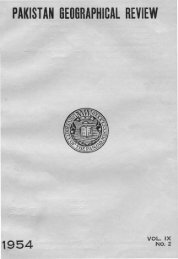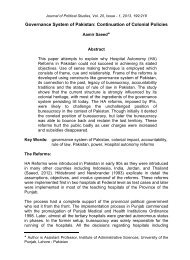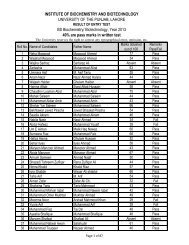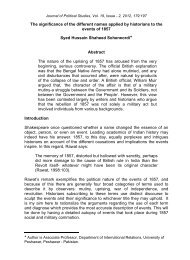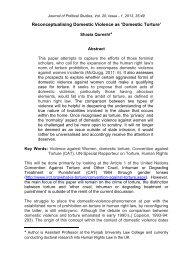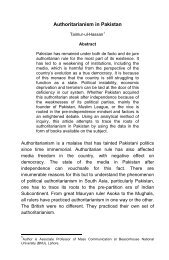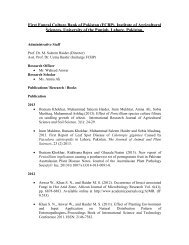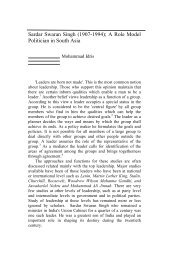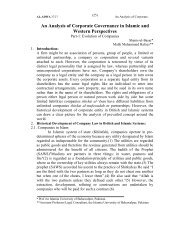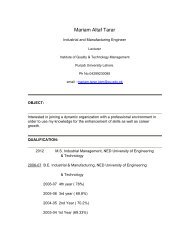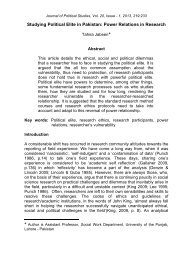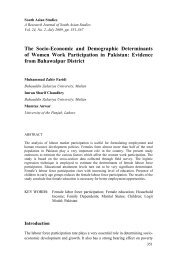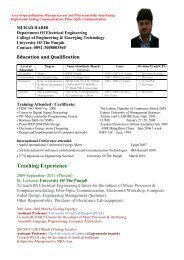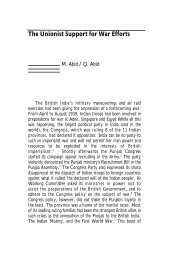Can Pakistan be a Secular State? - University of the Punjab
Can Pakistan be a Secular State? - University of the Punjab
Can Pakistan be a Secular State? - University of the Punjab
You also want an ePaper? Increase the reach of your titles
YUMPU automatically turns print PDFs into web optimized ePapers that Google loves.
South Asian Studies 28 (1)<br />
personal life, people’s <strong>be</strong>haviour was characterised by restraint and duty” (Brown<br />
C. 2006: 177-179). Michael Snape insists that “even in decline <strong>of</strong> religious<br />
practice should not blind us to <strong>the</strong> fact that, even at this later date, British society<br />
was still identifiably and self-consciously Christian” (Snaps M. 2005: 20).<br />
Long Sixties<br />
Nineteen sixties have <strong>be</strong>en treated as a hallmark <strong>of</strong> <strong>the</strong> irreligiosity when <strong>the</strong><br />
decline <strong>of</strong> religious practice had <strong>be</strong>en much more rapid in Britain. Callum Brown<br />
determines <strong>the</strong>se long sixties revolution in years <strong>of</strong> 1956-1973 (Brown C. 2006:<br />
224-227). He wrote <strong>the</strong>se are <strong>the</strong> years when “religion started to stop mattering in<br />
<strong>the</strong> 1960s British society as compare to <strong>the</strong> 1950s and <strong>the</strong> pre-fifties when it<br />
mattered significantly and deeply” (Brown C. 2001: 7). Main indicators <strong>of</strong><br />
secularization were churches in crises, non sacralisation <strong>of</strong> rites de passage and<br />
ascendancy <strong>of</strong> impiety. Callum Brown narrated, “The crisis in <strong>the</strong> church was<br />
reflected in <strong>the</strong> fact that Church mem<strong>be</strong>rship remained only 33% <strong>of</strong> <strong>the</strong> total<br />
populace. By <strong>the</strong> year 2000 less than 8% <strong>of</strong> people attended Sunday worship in<br />
any week and not as much <strong>of</strong> a tenth <strong>of</strong> children attended Sunday school”. (Brown<br />
C. 2001: 3) He fur<strong>the</strong>r wrote that Churches were in short <strong>of</strong> recruits to <strong>be</strong> priests<br />
and ministers and it resulted in <strong>the</strong> prediction <strong>of</strong> <strong>the</strong> demise <strong>of</strong> <strong>the</strong> Church <strong>of</strong><br />
Scotland by 2033 due to loss <strong>of</strong> mem<strong>be</strong>rship. Similarly fewer than half <strong>of</strong> couples<br />
get married in <strong>the</strong> Church and statistics display that if 72% <strong>of</strong> <strong>the</strong> marriages took<br />
place in <strong>the</strong> Church <strong>of</strong> England in 1957 it decreased to 55% in 1997. About 20%<br />
(228 <strong>of</strong> 1000) <strong>of</strong> <strong>the</strong> children were baptised in <strong>the</strong> Church in 1997 as compared to<br />
60% (602 out <strong>of</strong> 1000) in 1956. Cohabitation <strong>of</strong> about one third <strong>of</strong> couples without<br />
marriage pronounces <strong>the</strong> degree <strong>of</strong> moral decay and impiety in <strong>the</strong> society <strong>of</strong> <strong>the</strong><br />
year 2000 (Brown C. 2001:3-7). Pertinent legislation during <strong>the</strong> 1960s reflects this<br />
pace <strong>of</strong> change towards drifting from conservative religious teachings prevalent in<br />
<strong>the</strong> society. The years 1959-1969 witnessed <strong>the</strong>se moves <strong>be</strong>ginning with <strong>the</strong><br />
Obscene Publication Act <strong>of</strong> 1959 which protected scientific and literary work from<br />
prosecution. Restrictions on gambling were relaxed in 1960 and on drinking in<br />
1961. Male homosexuality was decriminalized in 1967. Theatre censorship was<br />
abolished in 1968 and in 1969 divorce law was li<strong>be</strong>ralized. This all extended <strong>the</strong><br />
sphere <strong>of</strong> individual freedom. Hugh McLeod is <strong>of</strong> <strong>the</strong> opinion that <strong>the</strong> trends<br />
established in <strong>the</strong> ‘long 1960s’ set <strong>the</strong> pattern for <strong>the</strong> rest <strong>of</strong> <strong>the</strong> century (McLeod<br />
H. 2007: 218).<br />
Why and how did it come about?<br />
The question as to, why and how can appropriately <strong>be</strong> gleaned from <strong>the</strong> <strong>be</strong>haviour<br />
<strong>of</strong> <strong>the</strong> clergy that held <strong>the</strong> pulpit and had <strong>be</strong>en <strong>the</strong> guardian and <strong>be</strong>neficiary <strong>of</strong><br />
Christendom for centuries. McLeod addressing <strong>the</strong> question narrates that, “since<br />
170



